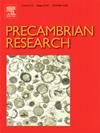Zircon U-Pb age and petrogenetic constraints on granitic magmatism from the southwestern Chhotanagpur Granite Gneiss Complex: Implications for Proterozoic crustal growth in the Central India
IF 3.2
2区 地球科学
Q2 GEOSCIENCES, MULTIDISCIPLINARY
引用次数: 0
Abstract
The Chhotanagpur Granite Gneiss Complex (CGGC) is an integral part of the Central Indian Tectonic Zone (CITZ), which records the Proterozoic tectono-thermal evolution of the Indian Shield. In this study, we carried out detailed petrography, bulk rock geochemistry, Nd isotopic studies and U-Pb zircon geochronology for granitoids from the southwestern CGGC. Four episodes of granitic magmatism from this area are documented, which are (i) c. 1660 Ma granite gneiss, (ii) c. 1565 Ma foliated granite, (iii) c. 1462 Ma porphyritic granite, and (iv) c. 1140 Ma equigranular granite. The c. 1660 Ma granite gneisses are migmatitic, I-type, and their Nd isotopic compositions are mildly sub-chondritic (εNd(t) = –0.90 to –2.55). The geochemical characteristics suggest them sourced from mafic to intermediate sources with inputs from pre-existing crustal rocks. The c. 1565 Ma foliated granites are peraluminous, S-type, and have evolved Nd isotopic composition (εNd(t) = –2.40 to –4.69) with Mesoarchean model ages, which suggests their derivation from a metasedimentary source. The c. 1462 Ma porphyritic granite and c. 1140 Ma equigranular granites have geochemical attributes similar to the A2-type granites. The strongly evolved Nd isotopic signatures (εNd(t) = –4.39 to –5.38 and –6.81 to –8.38) for porphyritic granite and equigranular granite, respectively, suggest inputs from both enriched mantle and pre-existing crustal sources. Based on these findings, the Proterozoic evolution of the CGGC can be broadly divided into four stages, with stages 1 and 2 corresponding to c. 1660–1565 Ma arc magmatism, where the granite gneisses were emplaced, followed by the emplacement of foliated granites in the waning stage. Stage 3 corresponds to the emplacement of c. 1462 Ma A-type granites associated with the extensional environment. Stage 4 is associated with post-collisional setting where the c. 1140 Ma equigranular granites were formed. The presence of recrystallized zircon domains with c. 900–1000 Ma in all granitoid variants supports widespread Grenvillian high-grade metamorphism in the CITZ. These results suggest that granitoids from the southwestern CGGC exhibit a transitional tectonic regime with an initial arc followed by extensional tectonics, culminating in a post-collisional environment, possibly linked with the breakup of Columbia and the amalgamation of Rodinia supercontinents.
Chhotanagpur花岗片麻岩杂岩西南部花岗质岩浆活动的锆石U-Pb年龄和岩石成因约束:对印度中部元古代地壳生长的启示
Chhotanagpur花岗片麻岩杂岩(CGGC)是印度中部构造带(CITZ)的重要组成部分,记录了印度盾元古代构造-热演化过程。本文对CGGC西南部花岗岩类进行了详细的岩石学、岩石地球化学、Nd同位素和U-Pb锆石年代学研究。记录了该区4期花岗质岩浆活动,分别为(i) c. 1660 Ma花岗片麻岩,(ii) c. 1565 Ma片理花岗,(iii) c. 1462 Ma斑岩花岗,(iv) c. 1140 Ma等粒花岗。c. 1660 Ma花岗岩片麻岩为混染型,为i型,其Nd同位素组成为温和的亚球粒质(εNd(t) = -0.90 ~ -2.55)。地球化学特征表明它们来自基性-中间源,并有先存地壳岩石的输入。c. 1565 Ma片理花岗岩为过铝质s型花岗岩,具有中太古代模式年龄的Nd同位素组成(εNd(t) = -2.40 ~ -4.69),表明其来源于变质沉积岩。c. 1462 Ma斑岩花岗岩和c. 1140 Ma等粒花岗岩具有与a2型花岗岩相似的地球化学属性。斑岩花岗岩和等粒花岗岩的Nd同位素特征(εNd(t)分别为-4.39 ~ -5.38和-6.81 ~ -8.38)强烈演化,表明既有富集地幔的输入,也有先存地壳的输入。综上所述,CGGC的元古代演化大致可划分为4个阶段,第1和第2阶段对应于c. 1660-1565 Ma弧岩浆活动,花岗岩片麻岩在此阶段侵位,在此阶段,片理花岗岩在此阶段侵位。第3阶段为c. 1462 Ma a型花岗岩侵位,与拉张环境有关。第4阶段与碰撞后的环境有关,在那里形成了约1140 Ma的等粒花岗岩。在所有花岗岩变异体中均存在c. 900-1000 Ma的再结晶锆石域,支持了在CITZ广泛存在的格伦维里亚高变质作用。这些结果表明,CGGC西南部花岗岩类表现出一个过渡性构造体系,其初始构造为弧形,随后是伸展构造,最终形成后碰撞环境,可能与哥伦比亚的分裂和罗迪尼亚超大陆的合并有关。
本文章由计算机程序翻译,如有差异,请以英文原文为准。
求助全文
约1分钟内获得全文
求助全文
来源期刊

Precambrian Research
地学-地球科学综合
CiteScore
7.20
自引率
28.90%
发文量
325
审稿时长
12 months
期刊介绍:
Precambrian Research publishes studies on all aspects of the early stages of the composition, structure and evolution of the Earth and its planetary neighbours. With a focus on process-oriented and comparative studies, it covers, but is not restricted to, subjects such as:
(1) Chemical, biological, biochemical and cosmochemical evolution; the origin of life; the evolution of the oceans and atmosphere; the early fossil record; palaeobiology;
(2) Geochronology and isotope and elemental geochemistry;
(3) Precambrian mineral deposits;
(4) Geophysical aspects of the early Earth and Precambrian terrains;
(5) Nature, formation and evolution of the Precambrian lithosphere and mantle including magmatic, depositional, metamorphic and tectonic processes.
In addition, the editors particularly welcome integrated process-oriented studies that involve a combination of the above fields and comparative studies that demonstrate the effect of Precambrian evolution on Phanerozoic earth system processes.
Regional and localised studies of Precambrian phenomena are considered appropriate only when the detail and quality allow illustration of a wider process, or when significant gaps in basic knowledge of a particular area can be filled.
 求助内容:
求助内容: 应助结果提醒方式:
应助结果提醒方式:


